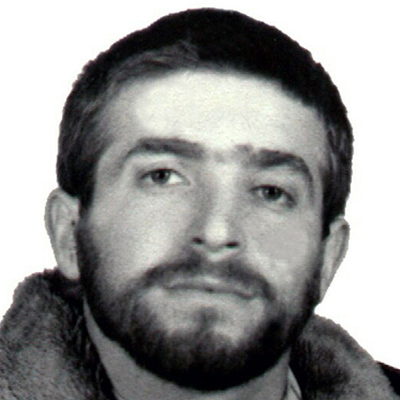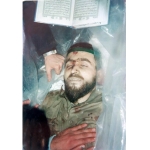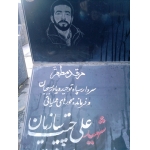People
Chitsazian, Ali
Behnaz, Bagherpour
238 دورہ
Ali Chitsazian was the commander of the Intelligence and Operations Unit of the 32nd Ansar al-Hussain (as) Division of the Islamic Revolutionary Guard Corps (IRGC) Ground Force during the Iran-Iraq War.
Born on January 30, 1963, in Hamedan, Ali Chitsazian was the third child in his family. His father’s name was Nasser and his mother’s name was Mansoureh.[1] He began his education in 1968 at Aref School[2] and later, continued his education at Keshavarz School in 1973. In 1977, he enrolled in Dibaj Technical School to study electricity.[3] Meanwhile, the Islamic Revolution was victorious, and he was amongst those who occupied the SAVAK headquarters in Hamedan.[4]
After the victory of the Islamic Revolution, Chitsazian dropped out of school, joined the Basij, and later became an official member of the IRGC.[5] On March 27, 1986, he married Zahra Panahi.[6] They had one son named Muhammad Ali,[7] who was born forty days after his father’s martyrdom.[8] During the Iran-Iraq War, Ali Chitsazian first went to Mehran where he was assigned to carry out reconnaissance operations as the Head of the Intelligence and Operation Unit by the commander of the Mehran sector, Ali Shadmani.[9] Then, due to his experience, he began training the forces at the Quds Garrison in Hamedan.[10]
Before Operation Muslim ibn Aqil executed on October 1, 1982, Hussain Hamedani (martyred) deployed a battalion of Hamedan’s IRGC fighters to the operation area of Soumar to support the 27th Muhammad Rasulullah (pbuh) Division;[11] in this operation, Chitsazian commanded one of the companies of the Kumayl Battalion of the 27th Muhammad Rasulullah (pbuh) Division.[12] They successfully infiltrated the city of Mandali inIraqi,[13] and captured 11 Iraqi soldiers.[14] Due to his achievements, he gained the attention of commanders and, at the age of 20, became the Head of the Intelligence and Operations Unit of the 27th Ansar al-Hussain (as) Brigade in Hamedan.[15] The Intelligence and Operations Unit of the brigade was deployed to Ilam where Chitsazian was tasked with conducting reconnaissance of the Mehran front,[16] to prepare the ground for launching Operation Valfajr 3.[17]
During Operation Valfajr 2 which was conducted in Haj Omran, he was injured in the leg. [18] However, after recovery, he came back to the frontlines to continue carrying out reconnaissance missions.[19] He later relocated the unit’s headquarters to Abu Zar Garrison in the Sarpol-e Zahab.[20] In late January of the same year, under the order of Hussain Hamedani, Chitsazian and his forces moved to Changuleh to plan on carrying out diversionary operations before Operation Valfajr 5[HR1] .[21] In this operation, he suggested using corded telephones instead of wireless devices to prevent the interception of intelligence, enabling an Iranian battalion to outflank Iraqi forces and control the Zarbatiyeh-Badreh Road.[22]
Chitsazian and his forces continued doing reconnaissance for Operation Ashura, which was carried out in 1984, in Meimak.[23]
In the summer of 1985 when Hussain Hamedani was replaced by Mahdi Kiani as brigade commander, Chitsazian moved with the brigade to the southern front and the Hoor al- Hoveyzeh [24] to participate in diversionary operations conducted prior to Operation Valfajr 8 on Umm al-Rasas Island and Buwarin.[25]
Following Operation Valfajr 8, the Intelligence and Operations Unit of the Ansar al-Hussain (as) Brigade took charge of reconnaissance for the second phase of this operation and was stationed at the outskirts of Khor Abdullah on the Faw–Umm al-Qasr Road.[26] On April 28, 1986, he participated in an operation carried out at the Faw salt factory, named Sahib al-Zaman (as).[27]
On May 27, 1986, the Ansar al-Hussain (as) Brigade was upgraded to a division,[28] of which Chitsazian was appointed head of the Intelligence and Operations Unit.
He participated in Operation Ansar launched on Majnoon Island in 1986[29] and was injured during doing reconnaissance for the fourth phase of Operation Karbala 5 in the Shalamcheh.[30] His brother, Muhammad Amir who had joined the Jihad of Construction Organization, was martyred on June 27, 1987, in Baneh after sustaining shrapnel injuries to his chest.[31]
On November 25, 1987, during Operation Nasr 8, Ali Chitsazian was martyred as a result of a mine explosion in the Mavout.[32] On November 29,[33] he was buried in Bagh Behesht Cemetery in Hamedan.[34]
A boulevard in Hamedan is named “Martyr Chitsazian”.[35] Books such as “Golestan-e Yazdahom (The Eleventh Garden)” by Behnaz Zarrabizadeh, “Dalil (The Guide)” by Hamid Hessam, and “Tappehhai-e Bimahtab (Moonless Hills)” by Ezzatollah Alvandi narrate the memories of Chitsazian’s family and comrades.
The book “Golestan-e Yazdahom”, which recounts the memories of Zahra Panahi Rava the wife of Chitsazian, received an endorsement from the Supreme Leader on February 9, 2017.[36] The books “Haftado Dovomin Ghavas (Seventy-Second Diver)”, the memoirs of Karim Motahari, commander of the Jafar Tayyar Battalion of the Ansar al-Hussain (as) Division, and “Vaqti Mahtab Gom Shod (When the Moonlight Disappeared)”, the memoirs of Ali Khosh-Lafz a member of the Intelligence and Operations Unit of the Ansar al-Hussain (as) Division, cover the life of Martyr Chitsazian. Also, in addition to his will,[37] several audio recordings containing his talks and speeches have been published.
[1] Mousavi, Seyyed Saeid, Farhangname-ye Javdaneh-ha-ye Tarikh (Encyclopedia of the Immortals of History), Zendeginameh-ye Farmandehan-e Shahid-e Ostan-e Hamedan, Daftar 25, Tehran, Nashr-e Shahed (Bonyad-e Shahid-e Enqelab-e Eslami), 1390, p. 91.
[2] Ibid., p. 91.
[3] Ibid. p. 92.
[4] Ibid.
[5] Ibid.
[6] Zarabizadeh, Behnaz, Golestan-e Yazdahom (The Eleventh Garden), Tehran, Entesharat-e Sureh-ye Mehr, 1395, p. 84.
[7] Mousavi, Seyyed Saeid, Ibid, Pp. 93 and 94.
[8] Hesam, Hamid, Dalil (The Guide), Tehran, Bonyad-e Hefz-e Asar va Nashr-e Arzesh-ha-ye Defa-e Muqaddas, 2nd Edition, 1387, p. 266.
[9] Ibid, p. 44; Hesam, Hamid, Haftad va Dovomin Ghavas (The Seventy-Second Diver), Qom, Shahid Kazemi, 2nd Edition, 1398, p. 132.
[10] Hesam, Hamid, Haftad va Dovomin Ghavas (The Seventy-Second Diver), p. 157.
[11] Ibid, p. 161.
[12] Hesam, Hamid, Dalil (The Guide), p. 53.
[13] Hesam, Hamid, Haftad va Dovomin Ghavas (The Seventy-Second Diver), p. 168.
[14] Hesam, Hamid, Vaqti Mahtab Gom Shod (When the Moonlight Disappeared), Tehran, Entesharat-e Sureh-ye Mehr, 1394, p. 258.
[15] Hesam, Hamid, Dalil (The Guide), Pp. 53 and 57.
[16] Hesam, Hamid, Vaqti Mahtab Gom Shod (When the Moonlight Disappeared), Pp. 271–272.
[17] Ibid., p. 287.
[18] Hesam, Hamid, Dalil (The Guide), p. 92; Hesam, Hamid, Haftad va Dovomin Ghavas (The Seventy-Second Diver), p. 199.
[19] Hesam, Hamid, Haftad va Dovomin Ghavas (The Seventy-Second Diver), p. 209.
[20] Ibid., p. 213.
[21] Ibid, Pp. 228–248; Hesam, Hamid, Vaqti Mahtab Gom Shod (When the Moonlight Disappeared), Pp. 303–305
[22] Hesam, Hamid, Dalil (The Guide), p. 99.
[23] Hesam, Hamid, Vaqti Mahtab Gom Shod (When the Moonlight Disappeared), p. 369.
[24] Hesam, Hamid, Haftad va Dovomin Ghavas (The Seventy-Second Diver), Pp. 324 and 326.
[25] Ibid, Pp. 325 and 342.
[26] Ibid, Pp. 346 and 348.
[27] Ibid, p. 365; Haji Khodaverdi Khan, Mahdi, Roozshomar-e Jang-e Iran va Iraq - Ketab 42 (Chronology of the Iran-Iraq War - Book 42), Vol. 1, Tehran, Markaz-e Asnad va Tahqiqat-e Defa-e Muqaddas, 1397, p. 77.
[28] Haji Khodaverdi Khan, Mahdi, Ibid, p. 664.
[29] Hesam, Hamid, Dalil (The Guide), Pp. 153 and 164.
[30] Ibid, Pp. 187, 198, and 199.
[31] Farhang-e Alam-e Shuhada (Vol. 15 - Ostan-e Hamedan) (Encyclopedia of Martyrs - Hamedan Province), Tehran, Nashr-e Shahed, 1393, p. 200.
[32] Mousavi, Seyyed Saeid, Ibid, p. 97.
[33] Zarabizadeh, Behnaz, Ibid, p. 280.
[34] Ibid, p. 253.
[35] https://neshan.org.
[36] Taqriz-e Rahbar-e Enghlab bar Ketab-e «Golestan-e Yazdahom» (Leader’s Commentary on the Book “The Eleventh Garden”), https://khl.ink/f/35595.
[37] Akbari, Manouchehr, Vasiyatnameh-ye Kamel-e Shuhada, Ostan-e Hamedan (Daftar 6) (Complete Testaments of Martyrs, Hamedan Province - Volume 6), Tehran, Nashr-e Shahed, 1395, p. 539.
[HR1]Can u give me the farsi for this? The English is a bit confusing








